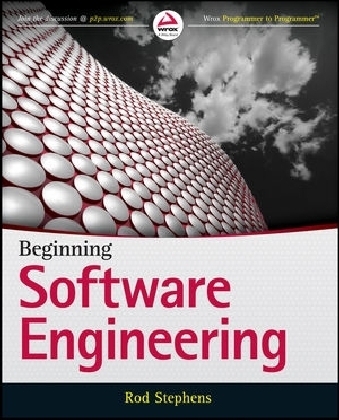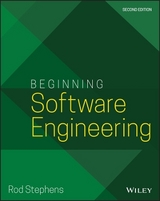
Beginning Software Engineering
John Wiley & Sons Inc (Verlag)
978-1-118-96914-4 (ISBN)
- Titel erscheint in neuer Auflage
- Artikel merken
* Describes in plain English what software engineering is * Explains the roles and responsibilities of team members working on a software engineering project * Outlines key phases that any software engineering effort must handle to produce applications that are powerful and dependable * Details the most popular software development methodologies and explains the different ways they handle critical development tasks * Incorporates exercises that expand upon each chapter's main ideas * Includes an extensive glossary of software engineering terms
About the author Rod Stephens started out as a mathematician, but while studying at MIT he discovered the joys of computer algorithms and has been programming professionally ever since. The author of more than 30 books, Rod is an award-winning instructor who speaks regularly at programming conferences and user's group meetings. Visit us at wrox.com where you have access to free code samples, Programmer to Programmer forums, and discussions on the latest happenings in the industry from around the world.
INTRODUCTION xxi PART I: SOFTWARE ENGINEERING STEP-BY-STEP CHAPTER 1: SOFTWARE ENGINEERING FROM 20,000 FEET 3 Requirements Gathering 4 High-Level Design 5 Low-Level Design 6 Development 6 Testing 6 Deployment 8 Maintenance 9 Wrap-up 9 Everything All at Once 10 Summary 11 CHAPTER 2: BEFORE THE BEGINNING 15 Document Management 16 Historical Documents 18 E-mail 19 Code 21 Code Documentation 22 Application Documentation 25 Summary 25 CHAPTER 3: PROJECT MANAGEMENT 29 Executive Support 30 Project Management 31 PERT Charts 33 Critical Path Methods 38 Gantt Charts 41 Scheduling Software 42 Predicting Times 42 Get Experience 44 Break Unknown Tasks into Simpler Pieces 44 Look for Similarities 45 Expect the Unexpected 45 Track Progress 46 Risk Management 47 Summary 49 CHAPTER 4: REQUIREMENT GATHERING 53 Requirements Defi ned 54 Clear 54 Unambiguous 55 Consistent 56 Prioritized 56 Verifiable 60 Words to Avoid 60 Requirement Categories 61 Audience-Oriented Requirements 61 Business Requirements 61 User Requirements 62 Functional Requirements 63 Nonfunctional Requirements 63 Implementation Requirements 63 FURPS 64 FURPS+ 64 Common Requirements 66 Gathering Requirements 67 Listen to Customers (and Users) 67 Use the Five Ws (and One H) 68 Who 68 What 68 When 69 Where 69 Why 69 How 69 Study Users 70 Refining Requirements 71 Copy Existing Systems 71 Clairvoyance 73 Brainstorm 74 Recording Requirements 76 UML 77 User Stories 77 Use Cases 78 Prototypes 78 Requirements Specification 80 Validation and Verification 80 Changing Requirements 80 Summary 81 CHAPTER 5: HIGH ]LEVEL DESIGN 87 The Big Picture 88 What to Specify 89 Security 89 Hardware 90 User Interface 91 Internal Interfaces 92 External Interfaces 93 Architecture 94 Monolithic 94 Client/Server 95 Component-Based 96 Service-Oriented 97 Data-Centric 97 Event-Driven 97 Rule-Based 98 Distributed 98 Mix and Match 99 Reports 101 Other Outputs 102 Database 102 Audit Trails 103 User Access 103 Database Maintenance 104 Configuration Data 104 Data Flows and States 105 Training 105 UML 105 Structure Diagrams 107 Behavior Diagrams 109 Activity Diagrams 110 Use Case Diagram 111 State Machine Diagram 112 Interaction Diagrams 113 Sequence Diagram 113 Communication Diagram 114 Timing Diagram 115 Interaction Overview Diagram 115 Summary 116 CHAPTER 6: LOW ]LEVEL DESIGN 119 OO Design 120 Identifying Classes 121 Building Inheritance Hierarchies 122 Refinement 123 Generalization 125 Hierarchy Warning Signs 126 Object Composition 127 Database Design 127 Relational Databases 128 First Normal Form 130 Second Normal Form 134 Third Normal Form 135 Higher Levels of Normalization 137 Summary 138 CHAPTER 7: DEVELOPMENT 143 Use the Right Tools 144 Hardware 144 Network 145 Development Environment 146 Source Code Control 147 Profilers 147 Static Analysis Tools 147 Testing Tools 147 Source Code Formatters 147 Refactoring Tools 148 Training 148 Selecting Algorithms 148 Effective 149 Efficient 149 Predictable 151 Simple 152 Prepackaged 152 Top-Down Design 153 Programming Tips and Tricks 155 Be Alert 155 Write for People, Not the Computer 156 Comment First 157 Write Self-Documenting Code 159 Keep It Small 160 Stay Focused 161 Avoid Side Effects 162 Validate Results 163 Practice Offensive Programming 165 Use Exceptions 166 Write Exception Handers First 167 Don t Repeat Code 167 Defer Optimization 167 Summary 169 CHAPTER 8: TESTING 173 Testing Goals 175 Reasons Bugs Never Die 175 Diminishing Returns 175 Deadlines 175 Consequences 176 It s Too Soon 176 Usefulness 176 Obsolescence 177 It s Not a Bug 177 It Never Ends 177 It s Better Than Nothing 178 Fixing Bugs Is Dangerous 178 Which Bugs to Fix 179 Levels of Testing 179 Unit Testing 179 Integration Testing 181 Automated Testing 182 Component Interface Testing 183 System Testing 184 Acceptance Testing 185 Other Testing Categories 185 Testing Techniques 186 Exhaustive Testing 186 Black-Box Testing 187 White-Box Testing 188 Gray-Box Testing 188 Testing Habits 189 Test and Debug When Alert 189 Test Your Own Code 189 Have Someone Else Test Your Code 190 Fix Your Own Bugs 192 Think Before You Change 193 Don t Believe in Magic 193 See What Changed 193 Fix Bugs, Not Symptoms 194 Test Your Tests 194 How to Fix a Bug 194 Estimating Number of Bugs 195 Tracking Bugs Found 195 Seeding 197 The Lincoln Index 197 Summary 198 CHAPTER 9: DEPLOYMENT 203 Scope 204 The Plan 204 Cutover 206 Staged Deployment 206 Gradual Cutover 206 Incremental Deployment 208 Parallel Testing 209 Deployment Tasks 209 Deployment Mistakes 210 Summary 211 CHAPTER 10: METRICS 215 Wrap Party 216 Defect Analysis 216 Kinds of Bugs 217 Discoverer 217 Severity 217 Time Created 218 Age at Fix 218 Task Type 218 Ishikawa Diagrams 219 Software Metrics 222 Qualities of Good Attributes and Metrics 223 Using Metrics 224 Process Metrics 226 Project Metrics 226 Things to Measure 227 Size Normalization 229 Function Point Normalization 231 Count Function Point Metrics 232 Multiply by Complexity Factors 232 Calculate Complexity Adjustment Value 233 Calculate Adjusted FP 235 Summary 235 CHAPTER 11: MAINTENANCE 241 Maintenance Costs 242 Task Categories 243 Perfective Tasks 244 Feature Improvements 245 New Features 245 The Second System Effect 245 Adaptive Tasks 247 Corrective Tasks 248 Preventive Tasks 251 Clarification 252 Code Reuse 253 Improved Flexibility 254 Bug Swarms 254 Bad Programming Practices 255 Individual Bugs 256 Not Invented Here 256 Task Execution 256 Summary 257 PART II: PROCESS MODELS CHAPTER 12: PREDICTIVE MODELS 265 Model Approaches 266 Prerequisites 267 Predictive and Adaptive 267 Success and Failure Indicators 268 Advantages and Disadvantages 268 Waterfall 270 Waterfall with Feedback 271 Sashimi 272 Incremental Waterfall 273 V-Model 275 Systems Development Life Cycle 276 Summary 280 CHAPTER 13: ITERATIVE MODELS 283 Iterative Versus Predictive 284 Iterative Versus Incremental 286 Prototypes 287 Types of Prototypes 288 Pros and Cons 289 Spiral 290 Clarifications 293 Pros and Cons 294 Unified Process 295 Pros and Cons 296 Rational Unified Process 297 Cleanroom 298 Summary 299 CHAPTER 14: RAD 303 RAD Principles 305 James Martin RAD 308 Agile 309 Self-Organizing Teams 311 Agile Techniques 313 Communication 313 Incremental Development 314 Focus on Quality 316 XP 317 XP Roles 318 XP Values 319 XP Practices 319 Have a Customer On Site 320 Play the Planning Game 320 Use Standup Meetings 321 Make Frequent Small Releases 322 Use Intuitive Metaphors 322 Keep Designs Simple 322 Defer Optimization 322 Refactor When Necessary 323 Give Everyone Ownership of the Code 323 Use Coding Standards 324 Promote Generalization 324 Use Pair Programming 324 Test Constantly 324 Integrate Continuously 325 Work Sustainably 325 Use Test-Driven and Test-First Development 325 Scrum 327 Scrum Roles 327 Scrum Sprints 328 Planning Poker 329 Burndown 330 Velocity 331 Lean 332 Lean Principles 332 Crystal 333 Crystal Clear 335 Crystal Yellow 336 Crystal Orange 337 Feature-Driven Development 338 FDD Roles 338 FDD Phases 340 Develop a Model 340 Build a Feature List 340 Plan by Feature 341 Design by Feature 341 Build by Feature 342 FDD Iteration Milestones 342 Agile Unified Process 343 Disciplined Agile Delivery 345 DAD Principles 346 DAD Roles 346 DAD Phases 347 Dynamic Systems Development Method 348 DSDM Phases 348 DSDM Principles 349 DSDM Roles 350 Kanban 351 Kanban Principles 352 Kanban Practices 353 Kanban Board 353 Summary 355 APPENDIX: SOLUTIONS TO EXERCISES 361 GLOSSARY 417 INDEX 437
| Erscheint lt. Verlag | 24.4.2015 |
|---|---|
| Verlagsort | New York |
| Sprache | englisch |
| Maße | 186 x 241 mm |
| Gewicht | 782 g |
| Themenwelt | Mathematik / Informatik ► Informatik ► Programmiersprachen / -werkzeuge |
| Mathematik / Informatik ► Informatik ► Software Entwicklung | |
| ISBN-10 | 1-118-96914-6 / 1118969146 |
| ISBN-13 | 978-1-118-96914-4 / 9781118969144 |
| Zustand | Neuware |
| Haben Sie eine Frage zum Produkt? |
aus dem Bereich



